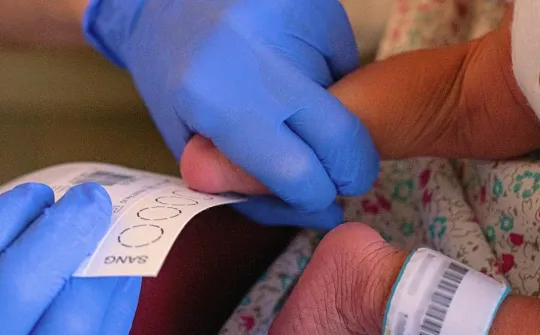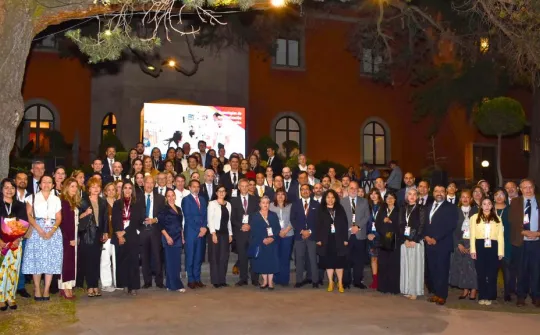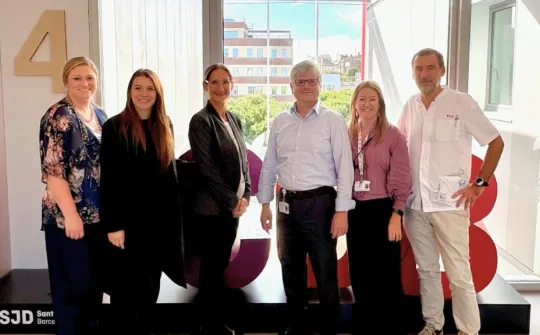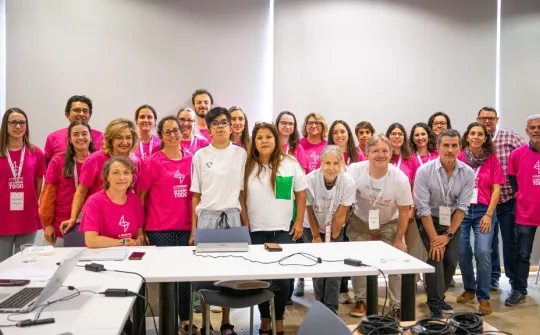‘Diagnosis is a right and a priority in the field of rare diseases so we are able to take action and prevent them’
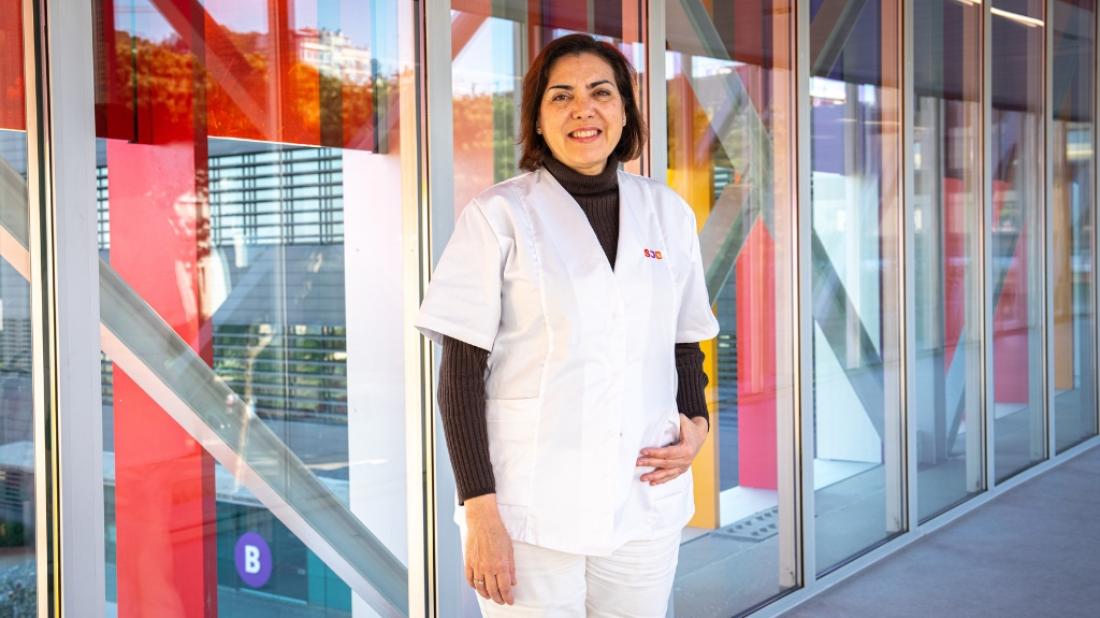
Head of the Genetics Department and Strategic Director of Únicas SJD, Encarna Guillén, discusses the challenges and advancements in the diagnosis, treatment and research of rare diseases and breaks down the innovative strategy used at the SJD Barcelona Children's Hospital.
Únicas SJD is a strategic project that originated at the SJD Barcelona Children's Hospital. Its aim is to improve healthcare services, diagnosis, treatment and research in the field of rare diseases. And Encarna Guillén is its Strategic Director. Although she has only recently stepped into this role, she has a significant professional career behind her. With a background in Pediatrics and Clinical Genetics, her previous professional work included a role as Head of Medical Genetics and of the Pediatrics Department at the Hospital Clínico Universitario Virgen de la Arrixaca in Murcia. She has been a key figure in the design of rare disease strategies at various levels and has been a long-standing member of the FEDER Assessment Committee.
She is a Senior Lecturer at the Universidad de Murcia and Principal Investigator at the IMIB-Pascual Parrilla, which is involved in several national research projects in the field of genomics and precision pediatric medicine. She is also President of the Spanish Association of Human Genetics and Vice-President of the UEMS (European Union of Medical Specialists) Section of Medical Genetics, who continue to fight for definitive regulation of the genetics specialisation in Spain.
What are your responsibilities at the SJD Barcelona Children's Hospital?
I coordinate the hospital's Genetics Department, which combines Medical Genetics and the Laboratory, where my fantastic colleagues conduct multidisciplinary work to help further the development and applications of genomic medicine at the SJD Barcelona Children's Hospital. The aim of our department is to increase the precision and speed of diagnosis for children with a suspected genetic disease, establishing the characteristics of their disease so we can identify effective treatment options. I am also Strategic Director of Únicas SJD.
How would you explain what Únicas SJD is?
The Únicas SJD project is a strategic plan that takes a comprehensive, integrative approach to adapting healthcare to pediatric patients with rare diseases. This approach involves providing comprehensive care to patients—any time, anywhere. It is a program that aims to achieve earlier and more precise diagnosis, ensuring greater access to advanced therapies and taking advantage of data and AI, for the benefit of both patients and medical staff. All of this happens within a collaborative framework, where patients and families can actively monitor how these advancements are having a positive impact on their daily lives.
Where did this idea for a strategic approach to rare diseases come from?
The idea was forged within the hospital itself after seeing a progressive increase in children living with rare diseases that are chronic and, oftentimes, degenerative, who require a great deal of care both inside and outside the hospital to improve their quality of life. They need to be able to access these services from their home or from their school. Staff at the SJD Barcelona Children's Hospital realised that something was needed that would allow us to improve in all of these aspects. A strategy that would change the game.
It is an ambitious project.
Yes, and that is why it is important to work in multidisciplinary teams, and more important yet, to be part of a network with other hospitals, other medical professionals and also other initiatives dedicated to researching and treating rare diseases. For example, the Únicas Network was created in 2023, launched by the SJD Barcelona Children's Hospital and the Spanish Federation for Rare Diseases (FEDER), headed and coordinated by the Ministry of Health and financed by Next Generation funds. This network, in which 30 Spanish healthcare facilities participate, aims to implement a data exchange platform to speed up diagnosis and to provide treatment options, thereby minimising the need for patients and their families to travel.
Why is diagnosis so important?
Diagnosis is a key starting point in making sound clinical decisions, changing the outlook for the patient and their family, as well as, more generally speaking, understanding the disease and how it can be tackled in the future. It is estimated that 80% of rare diseases are genetic in origin. That is why the development and implementation of genomics is so important to diagnosis, ensuring it is obtained as early and accurately as possible.
How long are we talking?
On average, confirming the diagnosis of a suspected disease takes approximately five or six years. It is really quite an unacceptable timeframe, but 20% take more than 10 years and some people even pass away before getting a diagnosis. In fact, in 35% of cases, the cause of death in children less than one year old is due to rare diseases. Time is a crucial factor, because sometimes we do not get the chance to provide targeted, personalised care, which really could make a difference for that child. Diagnosis is a right, and a priority in this field.
That is why, once the healthcare aspects of genetic studies have been done—namely the basic service offering of the national health system—the patient must not be forgotten about. We believe that they should be incorporated into our undiagnosed cases program, coordinated alongside IMPaCT GENóMICA, a national network that allows for equitable access to advanced, high-complexity genetic studies , with the aim of resolving unconfirmed cases as technology and knowledge grows and advances.
What would allow for more rare diseases to be screened for?
Neonatal screening allows us to anticipate the onset of the symptoms of certain diseases. This is crucial because many diseases are irreversible if not diagnosed and treated quickly. So forging ahead is what really opens doors for us.
Right now, we are taking part in two new national neonatal genomic screening projects on top of the previous GenNatal project: one is GeneBorn, involving all of the Spanish Autonomous Communities, with a sample of 1000 newborns; the other is CrinGenEs, in which nine Autonomous Communities are involved and which has a sample of 2,500 newborns. Here, screening will be based on the use of genetic tools to identify more than 300 different genetic diseases. Compared to the around 40 diseases that are screened for right now, this is a huge step up, qualitatively speaking.
The first Únicas Hackathon for rare diseases will take place in Murcia on 6 and 7 October. What does it entail?
The first Únicas Hackathon for undiagnosed rare diseases is a groundbreaking event with one specific task in mind: providing a diagnosis to children who have not yet received one after exhausting all possible healthcare options. Its equitable perspective means, in addition to the children selected from hospitals that are part of the ÚNICAS Network, children from Latin America who have been referred by their clinical teams have also been included. The Hackathon features the involvement of IMPaCT GENóMICA and several professionals from Latin America and Europe so that, in just 48 hours, we are able to analyse and integrate all of the previously obtained genetic sequences containing the clinical characteristics of the patients, with the aim of finding a diagnosis for as many cases as possible.
What does the future of research and treatment of rare diseases look like on a global level?
In recent years, there have been huge advancements made in the field of diagnostics, because genetic technology has evolved so quickly. However, when it comes to treatment, only 6% of rare diseases currently have a targeted therapy. That is why it is essential to continue researching new therapeutic options. Without a shadow of a doubt, the Advanced Therapies Platform at our hospital is playing—and will continue to play—a huge role in this work. Gene therapy and RNA- or protein-based treatments are giving us new hope that we can alter the course of many diseases, and improve the quality of life of those that have them.
And what does the Genetics Department at the SJD Barcelona Children's Hospital want to improve on?
We at the Genetics Department want to keep developing genomic medicine at our hospital, taking a comprehensive, multidisciplinary approach to help prevent diseases (through genetic counselling), provide early diagnosis, and identify new therapies that improve the quality of life of the children living with rare diseases.
With this goal in mind, we are updating all of our infrastructures—genomic, data storage and integration, process accreditation systems, staffing and healthcare protocols—by training multidisciplinary teams for each group of genetic diseases.
In addition, we are working towards integrating and supporting genetics and genomics applications in each and every clinical hospital department to achieve earlier and more precise diagnosis for patients and to help provide personalised treatment. All this while working hand-in-hand with national and international cooperative projects and networks.
And we have not forgotten about the children who, even after exhausting all standard clinical studies, are still undiagnosed. This is only the case because science still has not progressed enough to identify the genes responsible, or because current technology is the inhibiting factor in reaching a diagnosis. These patients must be periodically reviewed, informed by new knowledge and technology. It is vital that we have programs dedicated to undiagnosed cases, such will be the case at the SJD Barcelona Children's Hospital.
Nica’s journey is a fundraising campaign that seeks to raise money to create a program for undiagnosed patients and to improve healthcare for children with rare diseases.
